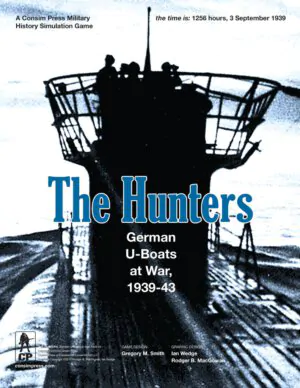
Publisher: Consim Press
Designer: Gregory M. Smith
Artists: John Kranz, Rodger B. MacGowan, and Ian Wedge
Year: 2013
Genre: Solitaire WWII German submarine wargame
Players: Solitaire, with rules for two players
Ages: 12+
Playing Time: Two to three hours
MSRP: $40.00
Listen to the podcast review here.
The Hunters: German U-Boats at War, 1939-43 is the latest release from Consim Press by way of our good friends at GMT Games. Here we have a solo title which places the player in the role of a U-Boat Kommandant set loose upon the shipping lanes of the U.K., USA, and Russia. Submarine warfare games have always been popular and very few topics are better suited for a solitaire game since there’s plenty of appeal to that cat and mouse game of a single vessel silently stalking unwitting prey on the high seas.
What’s in the Box
The object of The Hunters is to take command of an Unterseeboot while undertaking various patrols in order to sink as much tonnage as possible while still living to see the year 1943. Designer Gregory Smith has discussed his biggest influence putting together this title was the 1981 Avalon Hill classic B-17, Queen of the Skies. If you’re not familiar with that venerable solo game, you would take command of a single B-17 in an attempt to survive twenty five (or maybe it was thirty since it’s been quite a while since I played) missions over France and Germany in the hopes of being sent back to the States once your aircraft and crew passed through the gauntlet.
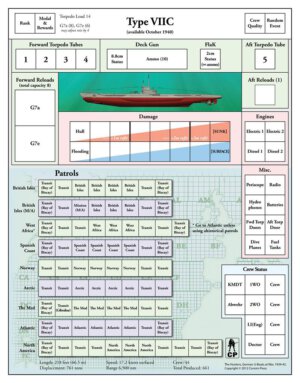
Cracking open the box (you’ll find this release to be touch lighter than most GMT productions) we’re in for much of what we’ve come to expect from GMT. The U-Boat mats and charts are printed on nice stock and the counters look good but I do have to mention the original rules could have used additional proof reading as they aren’t as squeaky clean as they could have been; diving into the game for the first time, everything isn’t laid out quite right to assist you in getting playing right away. I’ll chalk that up to this being a Consim Press release manufactured by GMT rather than being GMT title from start to finish.
Thankfully, The Hunters is being supported through what GMT likes to call “living rules” so an updated rulebook as well as additional charts and variants are available which polish up the title quite a bit. Honestly it would have been nice to have these from the start and I’m sure some folks out there won’t be overly keen on what effectively boils down to reprinting nearly everything included in the game outside of the counters and U-Boat mats in order to get the most out of the game. This isn’t to say the original boxed edition’s rules are broken – you can easily play with what’s in the box – but you’ll be vastly better served having the updates.
Let’s get something out of the way right up front: Some folks will surely love The Hunters while others will be a hell of a lot less than enamored. This will have much to do with how you feel about spending much of your playing time consulting charts. While this isn’t a title like Legion Wargames’ B-29 Superfortress, which multiplied B-17’s chart consulting to the Nth degree, you’ll still find a great deal of randomness as you’ll constantly roll dice to determine the patrols assigned, chances for encounters, precisely what you’ve encountered and how the engagement plays out, promotions, and so forth.
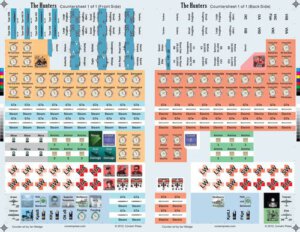
Gameplay breaks down into choosing a starting U-Boat, from the eight which are modelled, which determines your starting month and year. Beginning earlier in the war increases the survivability of your vessel (at least early on because you’ll encounter more unescorted ships) with the tradeoff of having less effective means of sinking shipping due to a greater proportion of torpedo duds and early war Unterseeboot capabilities. Starting your campaign later provides you with deadlier U-Boats but you’ll have to deal with more convoys, escorts, and aircraft all looking to leave you and your crew as casualties of war, resting on the bottom of the ocean.
Once you’ve selected your submarine and starting point you’ll set up your U-Boat mat with counters to reflect the crew status, damage, torpedo type and number, and so on. As you continue through a patrol your crew can become injured or killed (as can the Kommandant), the vessel can become damaged or sunk, and ammunition expended so you’ll track all of these things on the mat. Quite a few other miscellaneous items are also accounted for too as well as the available patrols for that given submarine.
Patrols are broken into a horizontal line of travel boxes which you’ll advance a counter across while rolling for encounters at each of these points. The patrols are assigned by rolling dice and consulting a chart which determines where you’ll be sent depending on what period of the war the patrol is taking place. There may be some restrictions on the patrol you’re assigned based on the type of U-Boat you command; i.e. a Type VII U-Boat wouldn’t be dispatched to patrol the Caribbean or West African coast because it wouldn’t have the range to do so effectively.
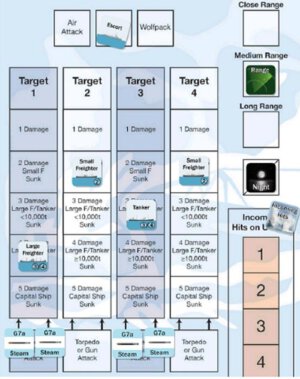
Combat against vessels provides you with a few options such as closing range (making it easier to hit the targets but also easier for you to be spotted), attacking at night on the surface (usually a good idea early in the war) or staying submerged, or using the deck gun against shipping targets. You’ll also decide how many torpedoes you’ll fire at any given target. You’ll be rolling those dice quite a bit to determine if your attacks strike home and if your targets end up resting in Davey Jones’ Locker. If the ships are being escorted you’ll also roll to see if you’re detected.
If your U-Boat is detected, the escort(s) will get to attack your sub as long as they can continue to maintain contact. Various types of damage to the U-Boat will aid the escorts in finding you and you’ll undergo a round of depth charge attacks. Many times the continuing attacks will inflict more and more damage until the sub is crippled, scuttled, or sunk. Then again a single lucky depth charge can end your career in a single roll of the dice too! As I mentioned if you’re spotted by aircraft then you’ll try to crash dive before they get off a depth charge attack.
If you survive your patrol, you’ll return to port to refit your submarine while also repairing damage, checking for crew promotion, look to advance your Kommandant in rank, heal if the Kommandant has been injured and possibly even receive a newer model of U-Boat for your next patrol. Through it all you’ll be chasing the coveted Knight’s Cross to be awarded to only the most successful commanders.
The Hunters comes to an end if your Kommandant is killed in action, or captured, or the game progresses to June 1943. Scuttling your submarine also leads to a very likely career end. The game also includes variants for two players (you’ll alternate patrols with one player controlling his U-Boat while the other rolls dice for escorts), tournaments, speeding up play, variable escort and aircraft quality, and more.
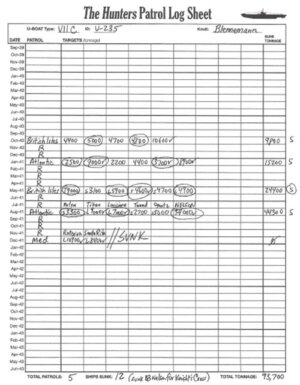
Personally, I’ve enjoyed The Hunters, German U-Boats at War 1939-43. It’s certainly not a perfect design, even with the updated rules, but it provides a solid experience which can be completed in about two to three hours; less if you encounter a stretch of extremely bad rolls. The title fills a nice niche in the current lineup of submarine games out there and is certainly worthy of occupying your time while you have the uncut BluRay of Das Boot playing in the background to provide the right mood.
[rwp-review id=”0″]
- Castles & Crusades: Players Handbook Reforged Edition Reviewed - Apr 7, 2025
- Campaign Builder: Dungeons & Ruins Reviewed - Apr 5, 2025
- Space 1999: The Roleplaying Game Receives a Free Quickstart - Apr 4, 2025



















Over all I think the game is fabulous. However; in saying that
I wish more mechanics were designed in the depth charges and
in aircraft attacks. Thanks
I would enjoy this solo sim but it seem a little bit unhistorical expecially at start. Air attack in 1939 were really rare and coastal guard planes were not the mighty catalina or B24 of 1943+ so air depht charge should be less lethal, even escorts were far from the efficient weapons of the late years so it seem that without asdic they are still too capable of depth charge you multiple times. Sinking loners with guns seem strangely too difficult like with G7 that are really too week if fired with magneto pistol and there is no rule to simulate indirect hit (more lethal) from direct hit (less lethal but in the early years less prone to dud result) with torpedoes? The rule regard exceding safety depht need really to be redone. A better historical reserch could have improved the game a lot.
Your criticisms are very valid. One way that I use to reduce escort deadliness is, in games that take place before May 1943, to add a -1 modifier for every escort attack after the first (this modifier is cumulative, so the second attack gets -1, the third gets -2, the fourth gets -3, etc.).
For air attacks, I too think the hit chart needs a bit more survival modifier than it has. I haven’t figured out a good way to do it yet, but it shouldn’t be too difficult.
As for the deck guns, I agree, but on the other hand, if they were beefed up, it would make it too easy to use them, and the game would feel more like a WW1 sub sim.
Personally, I think the “exceeding safety depth” rule is silly. The fact is, Allied depth charges weren’t set even close to the test depths for U-boats, and the idea that early war depth charges were good for anything beyond the first few minutes after a U-boat dived is ridiculous. Even late in the war, depth charges were effective more for their psychological effect than anything else.